Tinderbox for History
There’s been some discussion of using Tinderbox for historical research on the Tinderbox Forum lately. Unfortunately, that’s drifted into hand-wringing over details — documentation bugs remembered from 2017, complaints that the [Return] key as a shortcut doesn’t work in Tinderbox exactly as it works in some other system.
I’m going to write a bit about how I might use Tinderbox to write some history. I’m not a historian: take that into account. I’m not going to actually do the historical research here (though I’m really tempted). I’m going to try not to make things up (hi, GPT!) but I’m going to wing things from memory: if for some reason you use anything here, check it. The examples will be real Tinderbox, but they’re toy examples at tiny scale. Fill in the rest.
A Topic
I’m interested in looking at Ostia in the 3rd and 4th century as a tourist town.
This isn’t a good research question. That comes later. I want to think about later Roman Ostia — the Ostia we know — through the lens of contemporary Wellfleet MA.
Ostia was the port of Ancient Rome. The Romans thought it had been founded as a military fort in the age of kings; there was a big sign commemorating the foundation by Ancus Martius, who was about as distant from our period as we are from Chaucer and Genghis Khan. Here it is:
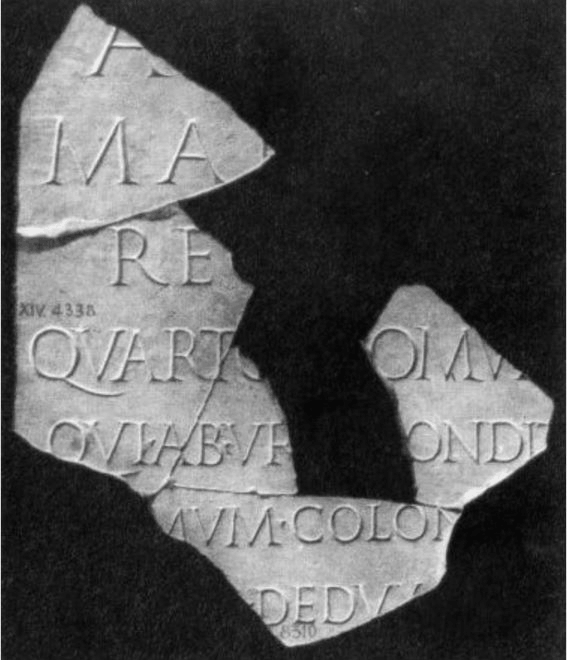
In the early Empire, Ostia had been one of the busiest ports of the world. Claudius rebuilt the harbor, but it was never entirely satisfactory and Trajan built a new and better harbor at Portus, just a bit up the coast. Ostia retained quite a few fancy houses, apartment buildings, and such for centuries after the business went to the new port. Eventually, the old harbor silted up completely, the Tiber shifted its course, and the whole place became a malarial swamp. As a result, it's remarkably preserved.
Wellfleet means “whale fleet”. A town on Cape Cod, it was an important harbor in the colonial era. The whaling industry was wrecked by the Revolutionary War, but fishing kept the town busy and prosperous through much of the 19th century. The long, slow decline of New England fishing gradually led the town to become a village of summer homes with a smattering of artists and artisans. Linda and I often spend a long weekend with friends. There are galleries and boutiques, good birding, plenty of fried fish and lobster and some more serious food. It’s fun.
Is it useful to think of 3rd century Ostia as something like Wellfleet?
Tourist Towns
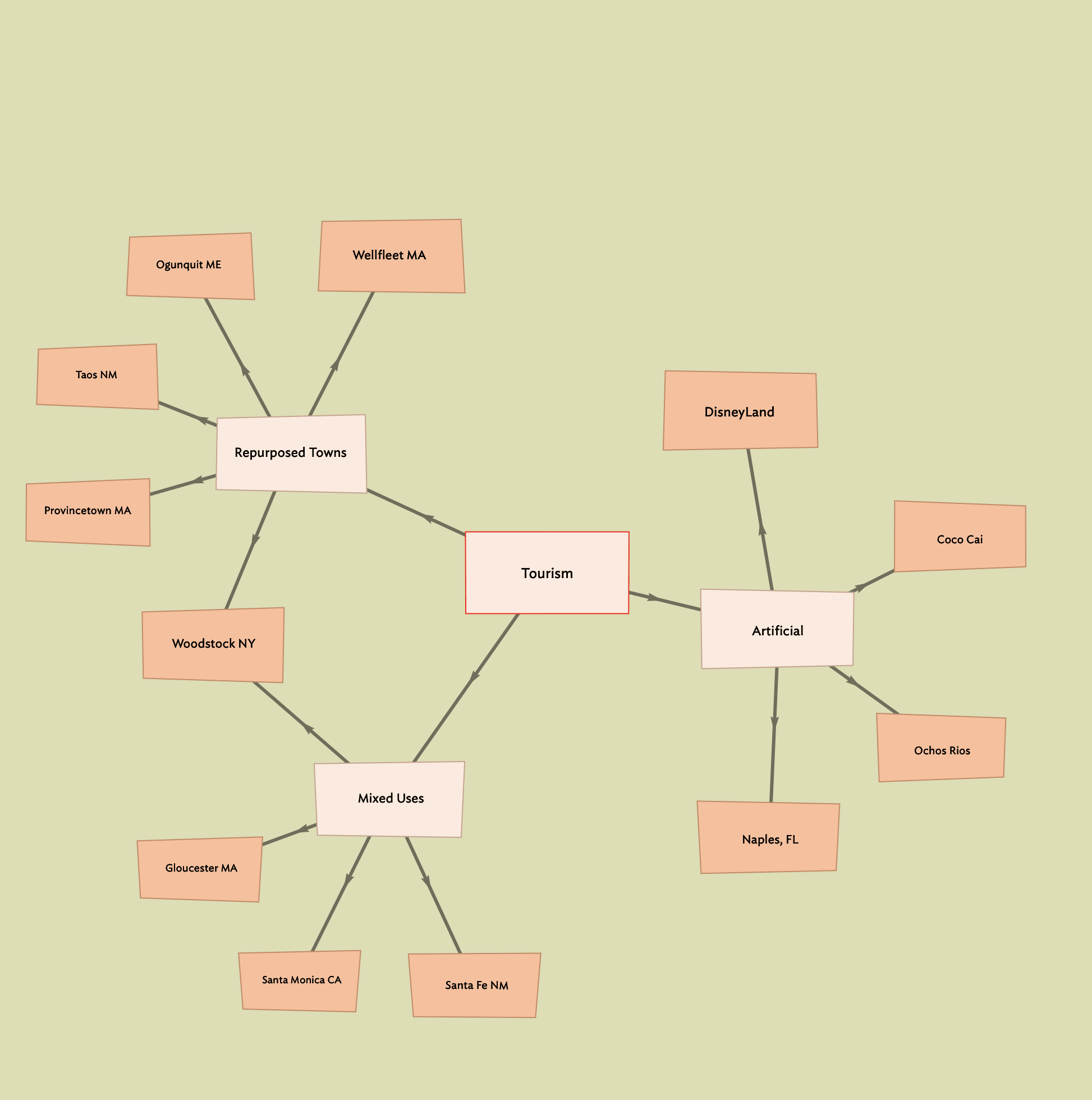
At the outset, decent research topics do tend to be fuzzy. That’s why premature formalization is bad, and it’s why we need Tinderbox.
That phrase, “like Wellfleet”, is frightfully vague. What does it mean? I don’t know! I suppose I’m wondering whether we should think all those little streetfront shops sold nails and farm supplies, or whether we should imagine them filled with souvenirs and knick-knacks. Do we think of those tabernae as dive bars, or trendy places to sample farmstead wine with a dish of tripe façon grand-mère. How might we know?
To pin down what “like Wellfleet” might mean, I started by dividing tourist destinations into three parts. Some destinations are entirely invented, like Disneyland. Some destinations are perfectly normal workaday places where people like to go — Santa Monica, say, or Santa Fe. You might live in Santa Monica because you work there, but people spend a lot of money to live there because it’s a nice place to live. If you go to a party in Woodstock NY, you might meet a third-generation goat farmer or you might meet a retired rock star.
Then, there are towns like Wellfleet that had a purpose, lost it, and tried something else.
This sort of brainstorming can be terrifically valuable at every stage of research. The Tinderbox map view is great for this. Here, though, I reached for the hyperbolic view, which views links:
- Automatic layout: you don’t need to fuss
- There’s always plenty of space: things not close to the center get smaller
- Adding notes is fast and easy
So, if 3rd century Ostia was a repurposed town, what might we expect to see?
Old Houses
One of the attractions of repurposed villages is that you can find fine old, old-fashioned houses. In cities, these places get cleared out because they sit on valuable land, but the land in the repurposed villages isn’t valuable anymore.
Ostia does have quite a few late houses of the traditional domus variety, some of which go back centuries. I don’t think it’s unreasonable to suppose an element of nostalgia — even nostalgia for an imagined past, or for someone else’s past. Your own ancestors may have been painting themselves in woad when the house was built, sure, but now you’re living like a Scipio.
Fancy Houses
It’s fun to live in an antique house, but that’s not for everybody. Some people want the latest comforts, and they want to be see to have those comforts. I think one place to look for those houses is along the (former) seacoast southwest of town. Another place to look is for conversions of old industrial or civic structures to residences — something hardly unknown in Ostia.
Tinderbox notes can handle quantitative and well as quantitative notes. Want to do a study of the number of domus buildings per block across the city? Want to study the ratio between shops and stairways? Add some attributes and away you go.
Don’t forget the attribute browser. If you make a note for each prominent building and have attributes for (say) surviving stairways, you can easily locate buildings with lots of stairs and examine their other properties.
Historic Markers
That big inscription for King Ancus we saw above is a sort of historic marker, but it’s also a convention of Roman iconography. Intriguingly, there’s another set of historical markers hiding in plain sight: signs scattered across the city that relate to Saint Monica — Santa Monica! — the mother of Augustine. She died in Ostia in 387 with Augustine at her side as they were waiting for a ship back to North Africa, and after her death it seems that someone made a point of marking out the real places you could get close to the Saint.
I recalled this because I read Boin’s Ostia In Late Antiquity a year or two back, and it made this interesting point. You don’t do this for locals: the people of Rome knew where Paul had been chained up and what the Colosseum was for. You put up historical markers for the transients, the summer people. George Washington stopped here: come inside for a cold beer!
I’ve never cited anything about Ostia in my computer science research, so none of it is in my Bookends Library. No worries: I opened Bookends and had it check the Library Of Congress index records for Boin’s book, and also Russell Meiggs wonderful Roman Ostia. I had Meiggs on Ostia at Swarthmore, and that semester casts a long shadow. ⌘⌥-drag the references into Tinderbox, and we’ve got reference notes all set to go.
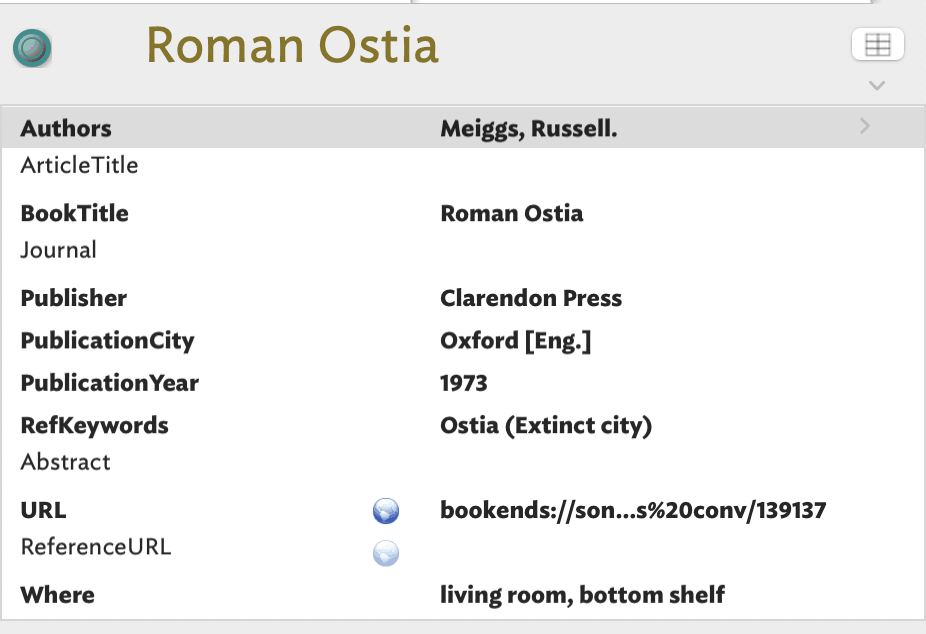
I added a new attribute, Where, because I’m in a hurry. Where is the book? I think it’s at home, in the living room. I am not going to look stuff up, lest I spend a week up to my elbows in Romans. But, if I need it, I think I know where it is.
This is an important aspect of Tinderbox. We don’t need to get the information architecture right from the outset. We can add the metadata we expect we will want. If you change your mind later, you can add more, or drop what didn’t prove useful.
Museums and Theaters
Repurposed towns need cultural amenities. The cost of redevelopment must be borne by people from more prosperous places, people who want to vacation in quaintness or retire to serenity. If the locals could afford it, we wouldn’t be redeveloping. But quaintness pales if you have to run up to town whenever you want a little fun or a bit of culture.
Ostia has a big and well-preserved theater, a possible art museum, a ton of public statuary, and a good deal of public parks and gardens. Wellfleet has two theater companies, a music venue just over the town line, and a bunch of galleries.
It might be interesting to take a look at surviving mosaics to see how they are distributed across the city, and how many are more or less public. That’s another nice use for map view. Maps of geographic maps aren’t a very profound use of spatial hypertext, but they make a nice kind of informal sketch that is exceptionally open to annotation and correction.
Weeds
In writing about museums and theaters, I recalled reading a paper that speculated that a particular late house, rather elite, might have housed a collection of old statues relocated from other parts of the city. I don’t remember the paper: I read history for fun and I don’t take systematic notes. But I thought it might be Mary Jane Cuyler, “Legend and Archaeology at Ostia: P. Lucilius Gamala and the Quattro Tempietti”, BABESCH 94 (2019), 127-146.
It wasn’t.
But good old Publius Lucilius Gamala is an old friend of mine, and this is a dandy paper. We start with a conference presentation from 1907 — Cuyler has one of the slides! — that presented one wrong theory about the “Four Temples” next to the theater. A big inscription called CIL XIV 375 once commemorated Mr. Gamala and lists his many good deeds, which include building four temples. There’s another, CIL XIV 376, that commemorates Mr. Gamala for restoring four temples. It’s easy to assume they’re the same guy, but 376 is probably a monument to a descendant of 375 who restored the temples that great-grandad built. (Even 375 had a father and grandfather with the same name: Romans did that, and so 376 might be P. Lucilius Gamala VIII for all we know.).
My teacher Meiggs walked us through these two inscriptions as a class exercise, in part because he’d solved the dating of 375 and established that 376 was a descendant emulating his ancestor. Cuyler has that solution — and a bunch of solutions proposed since then! She also has a comprehensive list of prior solutions and their arguments. (The original Lucilius Gamala may well have started out in Galilee where there was a town named Gamala, now Gamla.) Getting the dates right also involves knotty problems involving references to fundraising for naval wars, public feasts, the period of time in which various abbreviations were fashionable, and more. We still have 376 but someone misplaced 375 a few centuries back.
This is a ton of fun. But we’re on deadline.
This is one of the core strengths of Tinderbox for historical research: links persist even though we may rename, move, and reinterpret notes, and links don’t require a fixed anchor. So, when Cuyler tells us to read D’Arms and Zevi, and cites the elogia of Arezzo (what’s that?) in connection with Silvio Panciera, we can note and link the references and chase them down later.
That day might not be today, but the links will be there when we need them.
Hotels
The Peutinger Table is a medieval copy of a Roman travel guide, showing facilities for official government travel. It shows Ostia as a “two-roof” stop which is pretty substantial: Naples and Brindisi have the same amenities.
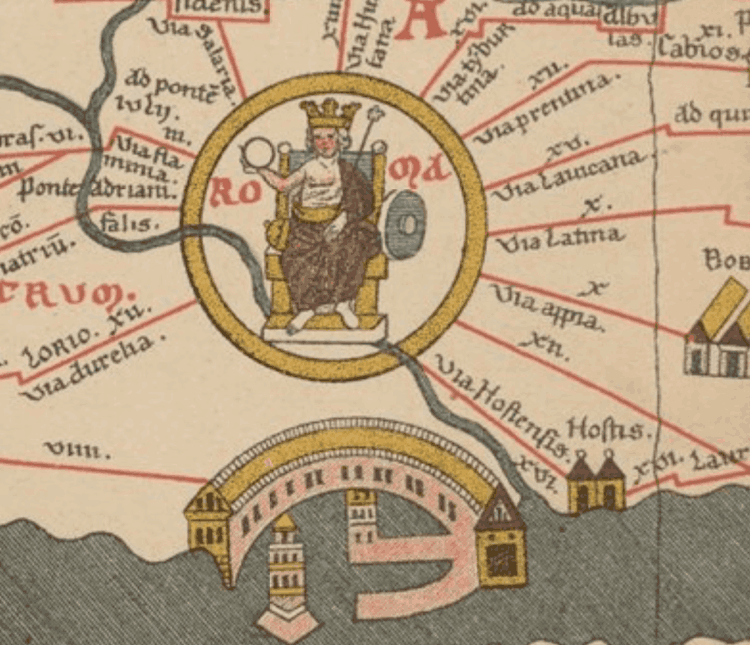
We don’t know exactly what facilities a “two-roof” town offered, but surely the point is that you’d know whether the town ahead was a place to stay, or you needed to push ahead to the next town with a decent hotel with a business center and a gym. Certainly, hotels and lodging houses are essential to repurposed towns.
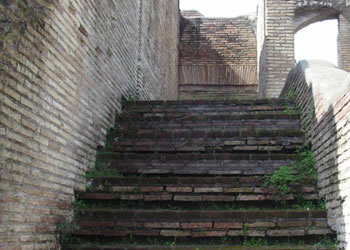
Here’s a stairway going up to the nice apartments on the first floor of a multistory Ostia apartment building. Might it have been a hotel at some point? You know what? When it comes to hotels in the Roman Empire, I’m pretty much drawing a blank. Nothing in the Oxford Classical Dictionary, either.
Very wealthy people, of course, would stay with friends or with “friends” wherever they went. Cicero, certainly, arranges to borrow people’s houses when they’re away. This might have been fairly widespread, and at a slightly more modest stratum money might have changed hands. This reminds me of the advertisement that precipitates Elizabeth von Arnim’s Enchanted April:
To Those Who Appreciate Wisteria and Sunshine. Small mediaeval Italian Castle on the shores of the Mediterranean to be Let furnished for the month of April. Necessary servants remain. Z, Box 1000. The Times.
Might those seaside villas have been let to visitors, along with necessary servants? I wonder, too, about Ostia’s many large apartment buildings, a number of which still stand to the height of several stories. In the first and second centuries, these would have been necessary for housing dockworkers, stevedores and longshoremen. Might some have served as Grand Hotels a century or two down the line? I’ve certainly paid handsomely to stay in remodeled servants’ rooms in repurposed fancy homes. What archaeological trace might point in that direction?
Links aren’t just for citation. Whenever historical research is going well, it throws off numerous questions to be pursued later. When it is not going well, it throws off even more questions. Speculations ought to be noted, and they ought to be marked as speculative. We turn from defining a technical term in German philology to noting some task that needs to be done.
Tinderbox’s suite of tools — agents to gather and organize, prototypes to classify, actions to enforce constraints — is the best way I know to handle this sort of radically heterogeneous information.
Restaurants
The food world of Ostia often seems strikingly familiar. Taverns (tabernae) had bars and bartenders, and behind the bar you’d see three shelves of deliciously intoxicating drinks. There were food shops with maritime mosaics built into their floors. Surely, these are the antecedents of Wellfleet’s Wicked Oyster?
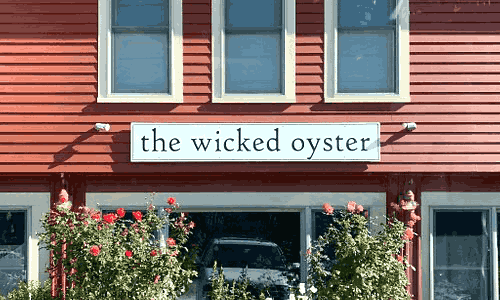
A new feature of Tinderbox is table view. You can view a bunch of notes as a table, which is handy if you’ve got a bunch of notes describing bars and eateries. Have a hankering to put that data in a spreadsheet? Just copy and paste. You can go in the opposite direction too, naturally.
Churches and Clubs
There are a lot of religious buildings in Ostia. OK: it was occupied for six or seven centuries, and religious structures tend to be conserved. Still, it’s a lot.
And that’s not counting the array of elaborate tombs lining the nearby roads. Romans viewed graveyards differently: they liked, for example, to have dinner parties in ancestral tombs, so grandpa could drop in.
But I think we ought to view those churches alongside all the “guilds” and civic orders and clubs, all of which are especially well attested in Ostia. There’s a synagogue just outside the seaward gate, which was enlarged and improved in the second century. There had been an earlier building on the site, but since there were pig bones in the debris, it probably wasn’t a synagogue. (You never know about pogroms, though Occam’s razor is at present an obstacle). All this clubbiness likely made it nicer for people relocating from the city, offering chunks of community into which the newcomer could find (or purchase) entrance.
We know lots of names from Ostia, not least because lots of the clubs had big plaques honoring their members. Nineteenth century epigraphers were great at indexing and cross-referencing these names, and perhaps this has all been covered satisfactorily.
But you might not be working in Ostia, and there are lots of areas that haven’t had nearly this level of scrutiny.
Do you think Mommsen and Dessau might have liked to have Tinderbox’s search tools? Take another look at that Ancus Martius inscription photographed above: you can get a lot of mileage from a piece of an A on one line and and “MA” on the next!
This sort of sifting is even more important in modern history, because there is more evidence than you can encompass.
Brothels
Last year, Robbie George briefly made Roman brothels the center of abortion controversy. It’s not clear that we know of any brothels in Ostia. There’s a candidate, but it may be better to view it as first-century mansion that, by the third century had become a fancy hotel.
Where do we start?
Eventually, this research ought to become a piece of writing.
How is it to be organized? Where will we start? Again, I think Tinderbox offers some very nice affordances that you don’t often see.
For example, we might begin with a view of Main St. Wellfleet, and move from there to repurposed towns and thence to specific ruins in Ostia.
Or, we might start with one specific building in Wellfleet: perhaps a fancy restaurant that used to be a very unfancy bar, and that before that was a private house that replaced a cottage where a colonial whaling captain had lived. That might give us a hook to the possible hotel.
With Tinderbox, we can experiment with many different organizations. We can look at transitions, change perspective and point of view. We can reverse the narrative and see if that works. The concreteness of Tinderbox notes lends itself to narrative experimentation.
Tinderbox For History
OK: times up, pencils down. That shot a perfectly good day.
All this is probably too elaborate. Still, it’s nice to know it’s there.
I haven’t talked much about actions — about the way notes can act on other notes to keep things organized. That’s really important for long-term projects.
I haven’t said anything about export. It’s pretty trivial nowadays. Select what you want to export, select the text, copy. Or export everything to plain text, RTF, Word, OPML, whatever. Your data is yours.
Questions? Email me.
Corrections? Let me know!
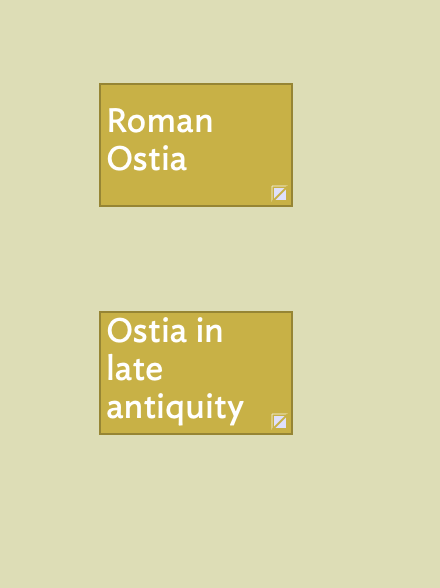
(This page, like the rest of the site, was written in Tinderbox)